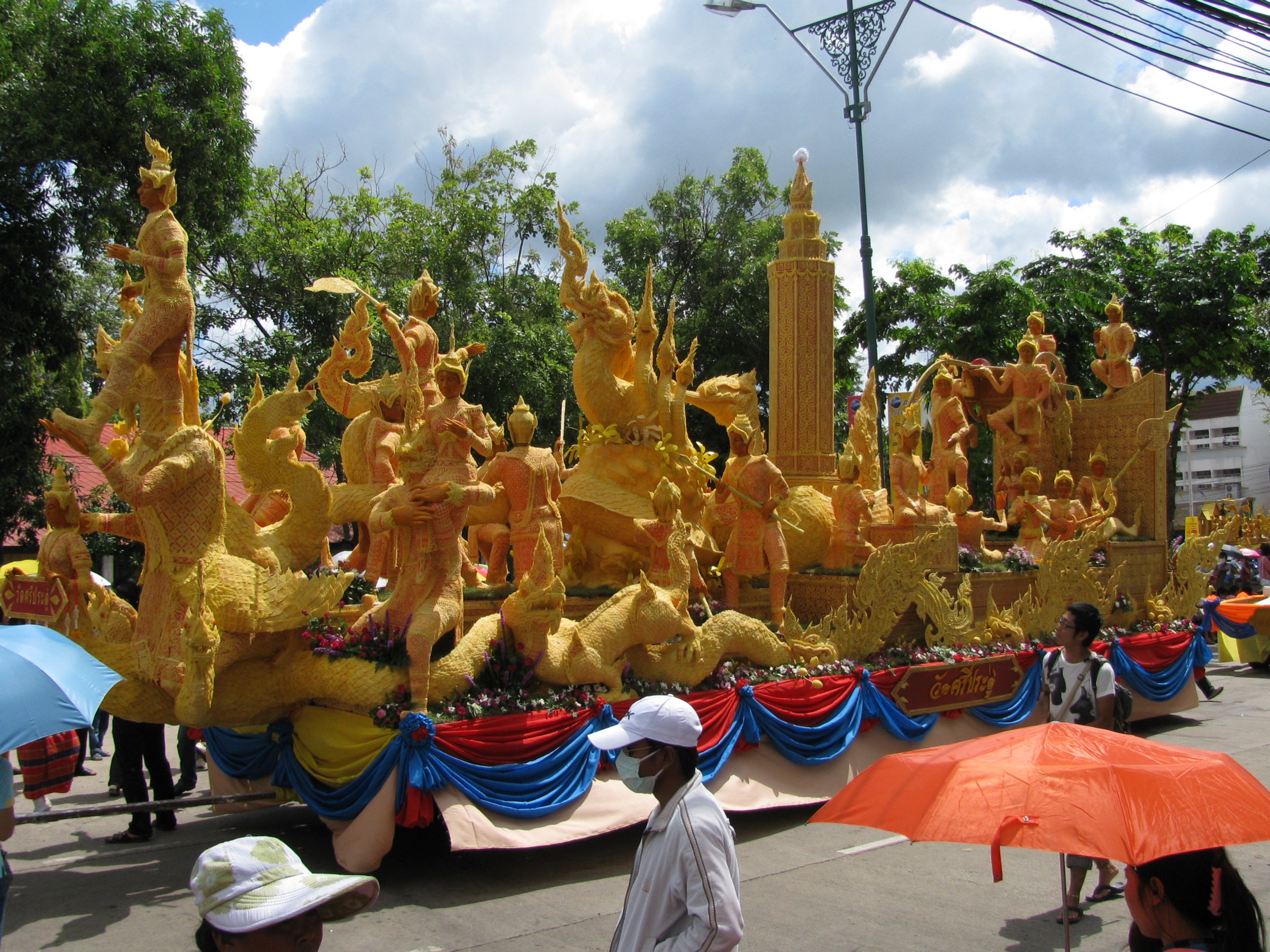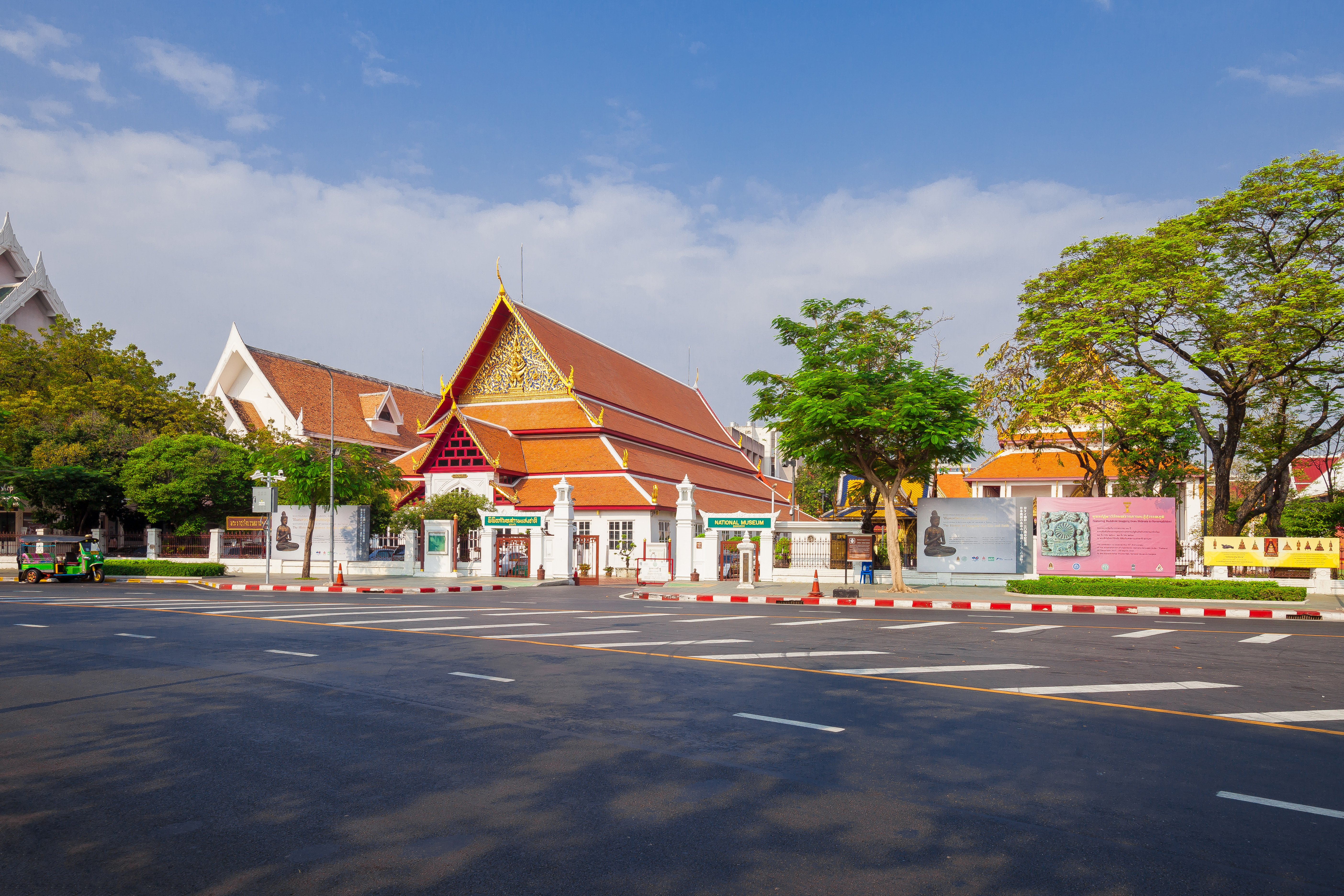|
Ho Trai
A ho trai ( th, หอไตร) is the library of a Thai Buddhist temple. A ho trai can come in different shapes and sizes. For many centuries, the sacred Tipiṭaka scriptures had been written on palm leaves. To preserve the scriptures against humidity and against termites, the library was often built on columns to raise the storage from the ground. Bricks were preferably used in constructions to battle termites. Sometimes the ho trai would be built, especially for this reason, above man-made ponds. Traditionally, the Tipiṭaka scriptures consisted of individual palm leaves, each measuring around 50 cm in length and around 4 to 6 cm in width. They were perforated and threaded in order to combine them in stacks of 20 to 40 pages. These stacks are kept pressed between two pieces of teakwood which is then wrapped in cloth and stored in a special bookcase. These bookcases are sometimes exquisitely crafted with mother-of-pearl inlay or with gold leaf applied on black lacquer. Bea ... [...More Info...] [...Related Items...] OR: [Wikipedia] [Google] [Baidu] |
Phetchaburi
Phetchaburi ( th, เพชรบุรี, ) or Phet Buri () is a town (''thesaban mueang'') in southern Thailand, capital of Phetchaburi Province. In Thai, Phetchaburi means "city of diamonds" (''buri'' meaning "city" in Sanskrit). It is approximately 160 km south of Bangkok, at the northern end of the Thai peninsula. As of 2005, the town had a population of 26,181 and covers the two ''tambon'' Tha Rap and Khlong Krachaeng. The runs through the middle of the city. The region is mostly flat, save for a single hill (called ''Khao Wang'') on the outskirts of town. The royal palace named |
Pitakataik (Mandalay)
Pitakataik ( my, ပိဋကတ်တိုက်; also Pitaka-taik) was the royal library in Mandalay, commissioned by King Mindon Min in 1857 during the founding of Mandalay as a royal capital. The library was one of 7 structures built to mark the foundation of consecration of Mandalay as the royal capital. It was located at the foot of Mandalay Hill, and was a masonry building with teak joints. The building was modeled after the Pitakataik in Bagan. Copies of Tipiṭaka texts were relocated from the Amarapura Pitakataik and deposited at the newly constructed library in January 1864. The Pitakataik was formerly stocked with Pali and Burmese palm leaf manuscripts which were looted with the onset of British occupation in 1885. In October 2013, the Sitagu Sayadaw announced a donation to rebuild the Pitakataik, along with the Thudhamma Zayat and Maha Pahtan Ordination Hall, with the consultation of Tampawaddy U Win Maung. See also *Tipiṭaka *Pitakataik *Pitakataik (Bagan) *Trip ... [...More Info...] [...Related Items...] OR: [Wikipedia] [Google] [Baidu] |
Pitakataik (Bagan)
The Bagan Pitakataik ( my, ပိဋကတ်တိုက်) is a library in Bagan. Pitakataik means "library of Buddhist Scriptures". The library in Bagan was created after a conquest of Thaton, where Anawratha seized 30 elephant-loads of Buddhist scripture. He then built a library in 1058 to house these documents. He used a style known as "Gu" which is an early Bagan Cave Style. The material was light-sensitive so the building had limited windows decorated with ''chinthe'' imaged on each side. There are three windows on each side. There are three doors which are all on one side (front). The library is square-shaped with each side measuring long. It was restored in 1738 by King Bodawpaya of the Konbaung Dynasty. The architecture of this library is notable because of its square shape, perforated stone windows and the plaster carvings that are on the roof which are examples of Myanmar architecture. See also *Tipiṭaka *Pitakataik *Pitakataik (Mandalay) *Tripiṭaka tablets at ... [...More Info...] [...Related Items...] OR: [Wikipedia] [Google] [Baidu] |
Pitakataik
''Pitakataik'' ( my, ပိဋကတ်တိုက်; also spelt ''bidagat taik'' and ''pitaka taik'') is a library of Buddhist scriptures, including the Tipiṭaka, found in Buddhist societies in modern-day Myanmar (Burma). History The ''pitakataik ''dates to the pre-colonial era. During the Pagan Kingdom era, Anawrahta commissioned a square-shaped ''pitakataik'' that measured , built in the style of a temple with a central plinth surrounded by a corridor, located from the Tharabha Gate. Subsequent monarchs, including Kyansittha, Htilominlo, and Kyaswa, continued the tradition of building ''pitakataiks'' during their reigns, ushering in a tradition of royals and laypersons alike commissioning ''pitakataiks''. By the First Toungoo Empire era, the ''pitakataik'' was considered a requisite edifice for a royal capital, and was built in Bayinnaung's capital of Hanthawaddy (now Bago, Myanmar). During the Mrauk U period, 48 pitakataik were established within the compounds of ... [...More Info...] [...Related Items...] OR: [Wikipedia] [Google] [Baidu] |
Dhamma Society Fund
Dhamma Society Fund, formally known as The M.L. Maniratana Bunnag Dhamma Society Fund under the Patronage His Holiness Somdet Phra Ñāṇasaṃvara the Supreme Patriarch of Thailand, is a charitable organisation in the Buddhist Theravāda Tradition, founded in 1997 by Thanpuying M.L. Manitatana Bunnag (1923–2000), Lady-in-Waiting to Her Majesty Queen Sirikit (1950–2000) and the Dhamma Society First Chairperson (1998–2000). Since 1999 the Dhamma Society Fund has undertaken the publication of the Tipiṭaka in Latin script, the World Edition. Recent activities focus on the Tipiṭaka, namely, organising Annual Tipiṭaka Lecture and Tipiṭaka presentation as a gift of Dhamma. Donations In 2000, Dhamma Society made a donation of its private collection of very rare palm-leaves Pāḷi Tipiṭaka and Pāḷi Tipiṭaka Editions (first edition) in various national scripts as well as in translations (over 3000 items) to the Faculty of Arts, Chulalongkorn University, which ar ... [...More Info...] [...Related Items...] OR: [Wikipedia] [Google] [Baidu] |
Khet Phasi Charoen
Phasi Charoen ( th, ภาษีเจริญ, ) is one of the 50 districts (''Khet'') of Bangkok, Thailand. The district is bounded by other Bangkok districts (from north clockwise): Taling Chan, Bangkok Noi, Bangkok Yai, Thon Buri, Chom Thong, Bang Bon, and Bang Khae. History The name of the district came from a canal, ''Khlong Phasi Charoen'' (คลองภาษีเจริญ), linking Tha Chin River to Khlong Bangkok Yai. The canal project was initiated by ''Phra Phasi Sombat Boribun'' (พระภาษีสมบัติบริบูรณ์), who later became ''Phraya Phison Sombat Boribun'' (พระยาพิสณฑ์สมบัติบริบูรณ์). Originally Phasi Charoen proposed to fund the project in exchange for the right to collect tolls for passage. It was approved by King Mongkut, however, with the fund given via tax deduction from the amount Phra Phasi Sombat Boriboon had to collect, thus making the canal toll-free. Constructi ... [...More Info...] [...Related Items...] OR: [Wikipedia] [Google] [Baidu] |
Khet Bangkok Noi
Bangkok Noi ( th, บางกอกน้อย, ) is one of the 50 districts (''khet'') of Bangkok, Thailand. Neighboring districts are (from north clockwise) Bang Phlat, Phra Nakhon (across Chao Phraya River), Bangkok Yai, Phasi Charoen, and Taling Chan. History Bangkok Noi was established as an amphoe on 15 October 1915. Originally named Amphoe Ammarin, it was renamed on 11 July 1916 to Amphoe Bangkok Noi to match with the historical name of the area. It became a khet in 1972 when Thon Buri and Bangkok were merged. Later on 9 November 1989 the Bang Phlat district was created from four of Bangkok Noi's sub-districts, leaving Bangkok Noi with four remaining sub-districts: Siri Rat, Ban Chang Lo, Bang Khun Non, and Bang Khun Si. On 12 December 1991 a small part of Bang Phlat district was moved back to Bangkok Noi, creating the new Arun Ammarin sub-district. Symbols The district seals shows the head of the royal barge Sri Suphunahongsa. The slogan of the district is ''Resonant ... [...More Info...] [...Related Items...] OR: [Wikipedia] [Google] [Baidu] |
Ubon Ratchathani
Ubon Ratchathani ( th, อุบลราชธานี, ) is one of the four major cities of Isan (with Khorat/Nakhon Ratchasima, Udon Thani, and Khon Kaen), also known as the "big four of Isan." The city is on the Mun River in the southeast of the Isan region of Thailand, and is located away from Bangkok. It is known as Ubon () for short. The name means "royal lotus city". Ubon is the administrative center of Ubon Ratchathani Province. As of 2006, the Ubon Ratchathani urban area had a population of about 200,000. This included 85,000 in Thetsaban Nakhon Ubon Ratchathani (Ubon municipality), 30,000 each in Thetsaban Mueang Warin Chamrap (Warin municipality) and Thetsaban Tambon Kham Yai, 24,000 in Thetsaban Tambon Saen Suk, 10,000 each in Thetsaban Tambon Pathum and Tambon Kham Nam Saep, and 6,000 in Thetsaban Tambon Ubon. History The city was founded in the late 18th century by Thao Kham Phong, descendant of Phra Wo and Phra Ta, who escaped from King Siribunsan of Vi ... [...More Info...] [...Related Items...] OR: [Wikipedia] [Google] [Baidu] |
Nan, Thailand
Nan ( th, น่าน, ) is a town in northern Thailand. It is north of Bangkok. It is in the centre of Nan Province which bears its name, and of which it is the former administrative capital. It covers ''tambon'' Nai Wiang and parts of ''tambon'' Pha Sing of Mueang Nan District, an area of divided into 30 ''chumchon''. In 2010 it had a population of 21,333 spread along the Nan River's right bank. Nan is a small city, primarily devoted to commercial, administrative, educational, and hospital activities. The old heart of the city, where Wat Phumin, the national museum and other tourist attractions are found, is being restored. History Nan for centuries was a separate, autonomous kingdom with few relationships with the outside world. There is evidence of prehistoric habitation, but it wasn't until several small ''mueang'' united to form ''Nanthaburi'' on the Nan River in the mid-14th century, contemporaneously with the creation of Luang Prabang and the Lan Xang (Million Elephan ... [...More Info...] [...Related Items...] OR: [Wikipedia] [Google] [Baidu] |
Bangkok National Museum
The Bangkok National Museum ( th, พิพิธภัณฑสถานแห่งชาติ พระนคร, ) is the main branch museum of the National Museums in Thailand and also one of the largest museums in Southeast Asia. It features exhibits of Thai art and history. It occupies the former palace of the vice king (or Front Palace), set between Thammasat University and the National Theater, facing Sanam Luang. The museum was established and opened in 1874 by King Chulalongkorn to exhibit the royal collections of his father King Mongkut. Today the galleries contain exhibits covering the Thai History back to Neolithic times. The collection includes The King Ram Khamhaeng's Inscription, which was inscribed on UNESCO's Memory of the World Programme registered in 2003 in recognition of its significance. Other than preserving and displaying Thai artifacts dating from the Dvaravati, Srivijaya, to Sukhothai and Ayutthaya periods, the museum also displays extensive col ... [...More Info...] [...Related Items...] OR: [Wikipedia] [Google] [Baidu] |
Library
A library is a collection of materials, books or media that are accessible for use and not just for display purposes. A library provides physical (hard copies) or digital access (soft copies) materials, and may be a physical location or a virtual space, or both. A library's collection can include printed materials and other physical resources in many formats such as DVD, CD and cassette as well as access to information, music or other content held on bibliographic databases. A library, which may vary widely in size, may be organized for use and maintained by a public body such as a government; an institution such as a school or museum; a corporation; or a private individual. In addition to providing materials, libraries also provide the services of librarians who are trained and experts at finding, selecting, circulating and organizing information and at interpreting information needs, navigating and analyzing very large amounts of information with a variety of resources. Li ... [...More Info...] [...Related Items...] OR: [Wikipedia] [Google] [Baidu] |




